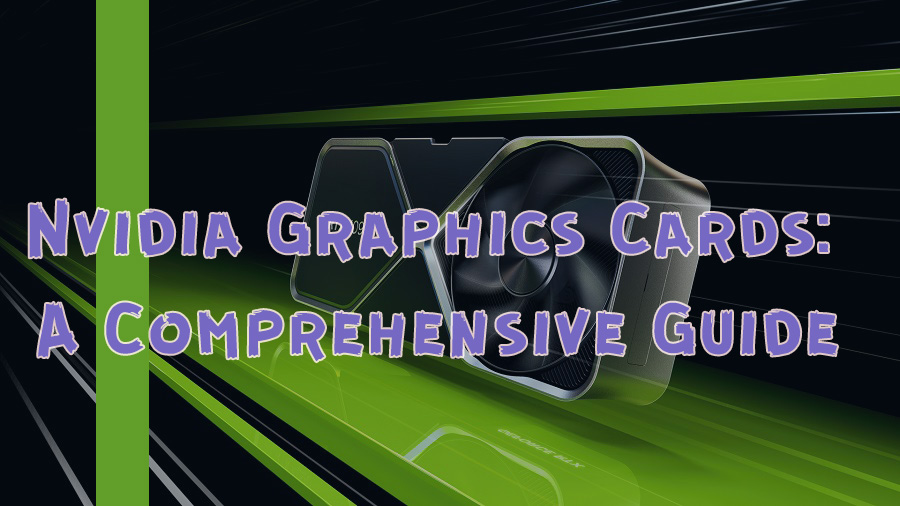Nvidia is a leading manufacturer of graphics processing units (GPUs) used in a variety of applications, including gaming, professional visualization, data center, and artificial intelligence. In this guide, we will provide a comprehensive overview of Nvidia graphics cards, their features, and their performance.
Nvidia Graphics Card Series
Nvidia offers several graphics card series, each with different features and specifications. Here are some of the most popular Nvidia graphics card series:
- GeForce RTX Series
The GeForce RTX series is designed for high-end gaming and features Nvidia’s latest technology, including real-time ray tracing and artificial intelligence-based rendering. These cards are available in various models, including the RTX 3060, RTX 3070, RTX 3080, and RTX 3090. - GeForce GTX Series
The GeForce GTX series is also designed for gaming and offers excellent performance for the price. These cards are available in various models, including the GTX 1650, GTX 1660, and GTX 1660 Ti. - Quadro Series
The Quadro series is designed for professional visualization and data center applications. These cards offer advanced features like ECC memory, simultaneous multi-projection, and VR support. The Quadro series includes models like the Quadro RTX 8000, Quadro RTX 6000, and Quadro P4000. - Tesla Series
The Tesla series is designed for high-performance computing and artificial intelligence applications. These cards feature Nvidia’s Tensor Cores, which accelerate AI workloads. The Tesla series includes models like the Tesla V100, Tesla P100, and Tesla T4.
Nvidia Graphics Card Features
Nvidia graphics cards come with a variety of features that enhance their performance and functionality. Here are some of the most important features to consider when choosing an Nvidia graphics card:
- CUDA Cores
CUDA cores are parallel processors that accelerate computing tasks. Nvidia graphics cards come with different numbers of CUDA cores, with higher-end cards featuring more cores. - Memory
Graphics cards come with their memory, which is used to store textures and other graphics-related data. Higher-end cards typically come with more memory, which allows them to handle more complex workloads. - Clock Speeds
Clock speeds refer to the frequency at which a graphics card’s processor operates. Higher clock speeds mean faster processing times, which results in better performance. - Cooling
Graphics cards generate a lot of heat, so it’s important to choose a card with an efficient cooling system. Nvidia graphics cards come with different types of cooling solutions, including air-cooled and liquid-cooled options.
Nvidia Graphics Card Performance
Nvidia graphics cards are known for their high performance and excellent graphics quality. Here are some benchmarks for popular Nvidia graphics cards:
- GeForce RTX 3090
The RTX 3090 is Nvidia’s flagship graphics card, designed for high-end gaming and professional applications. It features 10496 CUDA cores, 24GB of GDDR6X memory, and a boost clock speed of 1.70 GHz. The RTX 3090 offers excellent performance in games and professional applications, with benchmarks showing it to be the fastest graphics card on the market. - GeForce RTX 3080
The RTX 3080 is another high-end gaming card, with 8704 CUDA cores, 10GB of GDDR6X memory, and a boost clock speed of 1.71 GHz. The RTX 3080 offers excellent performance in games, with benchmarks showing it to be significantly faster than the previous generation of graphics cards. - Quadro RTX 8000
The Quadro RTX 8000 is designed for professional visualization and data center applications, with features like 48GB of GDDR6 memory, 4608 CUDA cores, and support for up to four 8K displays. Benchmarks show that the Quadro RTX 8000 is one of the fastest graphics cards for professional applications, with excellent performance in tasks like rendering, simulation, and machine learning. - GeForce GTX 1650
The GTX 1650 is a budget gaming card that offers excellent value for its price. It features 896 CUDA cores, 4GB of GDDR5 memory, and a boost clock speed of 1.65 GHz. While it doesn’t offer the performance of higher-end cards, the GTX 1650 can handle most modern games at 1080p resolution. - Tesla V100
The Tesla V100 is a high-performance computing card designed for AI workloads. It features 5120 CUDA cores, 16GB of HBM2 memory, and 640 Tensor Cores, which accelerate AI workloads. Benchmarks show that the Tesla V100 is one of the fastest graphics cards for AI workloads, with excellent performance in tasks like image recognition and natural language processing.
Buying an Nvidia Graphics Card
Nvidia graphics cards are widely available from a variety of retailers, including online stores like Amazon and Newegg, and brick-and-mortar stores like Best Buy and Micro Center. When buying an Nvidia graphics card, there are a few things to consider:
- Price
Nvidia graphics cards range in price from under $100 to over $1,500. Higher-end cards offer better performance, but they also come with a higher price tag. - Compatibility
Nvidia graphics cards require a compatible motherboard and power supply. Make sure your system is compatible with the card you’re considering before making a purchase. - Availability
Due to high demand, some Nvidia graphics cards may be out of stock or subject to price fluctuations. Keep an eye on availability and price trends before making a purchase. - Warranty
Nvidia graphics cards typically come with a manufacturer’s warranty, which can range from one to three years. Make sure to check the warranty before purchasing to ensure you’re covered in case of a defect or malfunction.
In conclusion, Nvidia graphics cards are a popular choice for gamers, professionals, and enthusiasts due to their high performance, advanced features, and wide availability. When buying an Nvidia graphics card, consider factors like price, compatibility, availability, and warranty to ensure you’re getting the best value for your money. With the right Nvidia graphics card, you can enjoy excellent gaming and computing performance, as well as high-quality graphics and visualizations.

